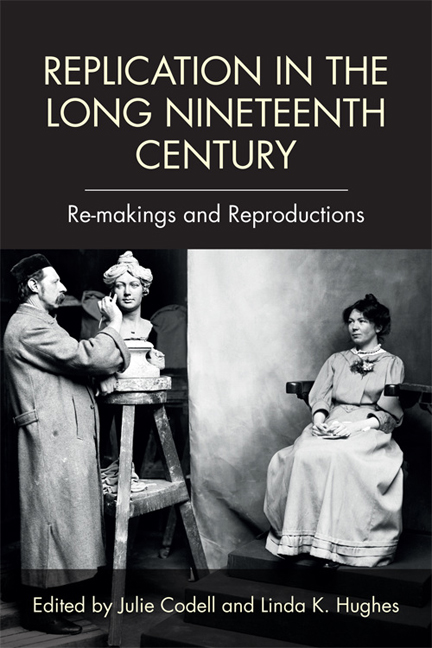Book contents
- Frontmatter
- Contents
- List of Illustrations
- Acknowledgments
- 1 Introduction: Replication in the Long Nineteenth Century – Re-makings and Reproductions
- I Replication and Networks
- II Replication and Technology
- III Replication and Authenticity
- IV Replication and Time
- 13 “Seeking Nothing and Finding It”: Moving On and Staying Put in Mugby Junction
- 14 The Origins of Replication in Science
- 15 Fathers, Sons, Beetles, and “a family of hypotheses”: Replication, Variation, and Information in Gregory Bateson's Reading of William Bateson's Rule
- 16 Afterword: The Implications of Nineteenth-Century Replication Culture
- Notes on Contributors
- Index
13 - “Seeking Nothing and Finding It”: Moving On and Staying Put in Mugby Junction
from IV - Replication and Time
Published online by Cambridge University Press: 11 August 2018
- Frontmatter
- Contents
- List of Illustrations
- Acknowledgments
- 1 Introduction: Replication in the Long Nineteenth Century – Re-makings and Reproductions
- I Replication and Networks
- II Replication and Technology
- III Replication and Authenticity
- IV Replication and Time
- 13 “Seeking Nothing and Finding It”: Moving On and Staying Put in Mugby Junction
- 14 The Origins of Replication in Science
- 15 Fathers, Sons, Beetles, and “a family of hypotheses”: Replication, Variation, and Information in Gregory Bateson's Reading of William Bateson's Rule
- 16 Afterword: The Implications of Nineteenth-Century Replication Culture
- Notes on Contributors
- Index
Summary
Mugby Junction was the 1866 Christmas number of Charles Dickens's weekly periodical All the Year Round. As per tradition, Mugby Junction was an ensemble piece organized around a theme, and this time Dickens chose a lightly fictionalized railway junction (Mugby stands for Rugby). Exploiting the railway's propensity to gather people together only to move them on, Dickens used Mugby to accommodate the various spooky tales contributed by himself and his fellow writers. Mugby Junction is about movement and things that move, whether trains and those who travel, the telegraph and the signals it relays, or the post and letters that circulate. But this concern with media and mediation also makes Mugby Junction peculiarly reflexive. The railways and their attendant technologies transformed print culture, and at the heart of Mugby Junction is a consideration of the specific kinds of movement enabled by industrial print. As was traditional at Christmas, these tales concern the haunted, the ghostly, and the compulsive, but the repetitions that mark the gothic also describe the rhythms of the press. Reading printed material is to read one copy of many, and the seriality of key print genres of the period – the periodical, the newspaper, and the part issue – meant that each issue was haunted by its predecessors even as it anticipated the issue to follow. Gothic economies of return threaten stasis, yet Mugby Junction illustrates the way that repetitive motion can be translated into a particular means of forward propulsion.
In this chapter I examine the way material media move in Mugby Junction, whether through space over the rails; through time, as one thing succeeds another; or through affect, as people are moved by what they receive. My argument, though, concerns the way this discussion of movement is framed. Dickens's first two contributions to Mugby Junction set up the conceit, telling us of a man called Barbox Brothers, the “gentleman for Nowhere,” who gets off the train at Mugby but travels no further (1866a: 7). In dramatizing Barbox Brothers's state of mind as he wanders up and down the platform, Dickens insists on the continuities between the steam engine and the heart, both mechanisms for repetitive motion that nonetheless move things on.
- Type
- Chapter
- Information
- Replication in the Long Nineteenth CenturyRe-makings and Reproductions, pp. 231 - 247Publisher: Edinburgh University PressPrint publication year: 2017



